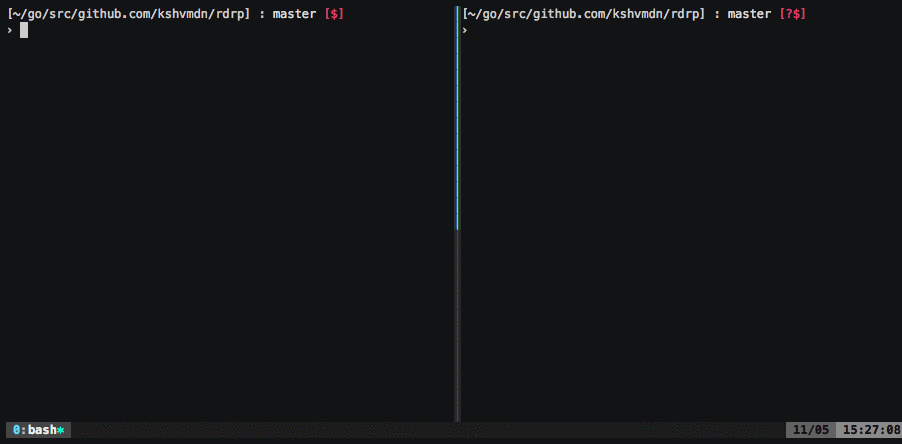A cross-platform command line tool for sending and receiving files over your local network, inspired by AirDrop.
rdrp uses Multicast DNS to enable peer-to-peer discovery between clients. This means that rdrp will likely not work in most cloud/virtual environments.
When a client first connects, they're registered as a new instance on the _rdrp._tcp service. Each sender continuously browses this service for newly connected broadcasters with whom they'll establish a connection and attempt to send their respective file.
This program implements mDNS with grandcat/zeroconf.
Read more about mDNS: RFC 6762 and DNS-SD: RFC 6763.
Go should be installed and configured.
Install with Go:
$ go get -v github.com/kashav/rdrp/...
$ which rdrp
$GOPATH/bin/rdrpOr, install directly via source:
$ git clone https://github.com/kashav/rdrp.git $GOPATH/src/github.com/kashav/rdrp
$ cd $_ # $GOPATH/src/github.com/kashav/rdrp
$ make install all
$ ./rdrpRun rdrp with the --help flag to view the usage dialogue.
$ rdrp --help
usage: rdrp [<flags>] <command> [<args> ...]
Send and receive files over your local network.
Flags:
--help Show context-sensitive help (also try --help-long and --help-man).
-n, --name=NAME Set your connection name.
-d, --debug Enable debug mode.
--version Show application version.
Commands:
help [<command>...]
Show help.
broadcast
Receive a file.
list [<flags>]
View active clients.
send [<flags>]
Send a file.
There's two parties involved in a single transaction: the sender and the receiver.
To send a file, use the send command. Provide the file path with the --file flag or pass the file's contents via stdin.
Every broadcaster will receive a request to transfer the file (unless names are specified with the --to flag). This process continues until aborted (Ctrl+C).
$ rdrp help send
usage: rdrp send [<flags>]
Send a file.
Flags:
--help Show context-sensitive help (also try --help-long and --help-man).
-n, --name=NAME Set your connection name.
-d, --debug Enable debug mode.
--version Show application version.
-f, --file=FILE Specify the transfer file (you may optionally pass your file via stdin).
--to=TO ... Comma-separated list of client names.
$ rdrp send --file=README.md$ rdrp send --name sender < README.md$ tar -cvzf archive.tar.gz /path/to/directory/
$ rdrp send --file=archive.tar.gz --to=a$ echo "hello" | rdrp send --to=b,cTo broadcast yourself as a receiver (i.e. someone receiving a file), use the broadcast command.
You'll be listening for incoming send requests. Upon a new connection, you'll be prompted on whether you'd like to accept the file or not, just like AirDrop. The incoming file is copied to stdout.
$ rdrp broadcast -help
usage: rdrp broadcast
Receive a file.
Flags:
--help Show context-sensitive help (also try --help-long and --help-man).
-n, --name=NAME Set your connection name.
-d, --debug Enable debug mode.
--version Show application version.
$ rdrp broadcast # output is copied to stdout
...$ rdrp broadcast --name b > archive.tar.gzNote that each of the above roles has an optional name flag, a name is chosen at random if not provided (which is what happened in the demo above).
You can view all connected clients with list. Use --type to specify the type of clients to list and --watch to listen for new connections.
$ rdrp list -help
View active clients.
Flags:
--help Show context-sensitive help (also try --help-long and --help-man).
-n, --name=NAME Set your connection name.
-d, --debug Enable debug mode.
--version Show application version.
-w, --watch Watch for new connections.
-t, --type="all" Specify which type of client to listen for.
Start off by cloning the repository (if you've already cloned, navigate to the project root):
$ git clone https://github.com/kashav/rdrp
$ cd rdrpBuild the Docker image:
$ docker build -t kashav/rdrp .And run it! The --rm flag automatically removes the container when the program exits.
$ docker run --rm kashav/rdrp [broadcast|list|send] ...This project is completely open source, feel free to open an issue or submit a pull request.
Before submitting a PR, please ensure that tests are passing and that the linter is happy. The following commands may be of use.
$ make install \
get-tools
$ make fmt \
vet \
lint
$ make test \
coverageThe demo GIF was generated with asciinema, with tmux.
rdrp source code is released under the MIT License.
